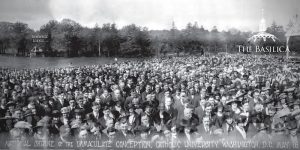
May 16, 2020 is the 100th anniversary of the blessing of the site of the future Basilica of the National Shrine of the Immaculate Conception. This significant event marked the beginning of the National Shrine’s construction process, which culminated in its dedication in 1959, and final completion in 2017 with the installation of its crowning jewel, the Trinity Dome.
At 9:30 a.m. on May 16, 1920, Archbishop Giovanni Bonzano, Apostolic Delegate to the United States, celebrated Mass and blessed the site of the future National Shrine. More than 6,000 people attended the event, including 1,500 Knights of Columbus and 500 Daughters of Isabella.

In many ways, this was the first pilgrimage to the National Shrine, as Catholic groups from across the country gathered to witness the event.
Bishop Thomas J. Shahan, who presented to Pope Piux X a plan to build a national church in honor of the Blessed Virgin Mary in Washington seven years prior, delivered the homily during this historic Mass. The Rev. Dr. A. L. Gabert, professor of Plain Chant at the University, directed a choir of 487 voices that included members of the affiliated religious communities of the University and 100 children from St. Vincent’s Orphanage.
The altar used at the Mass was used by the first Catholic bishop of the United States, Bishop John Carroll, and dated to 1774. This altar was used for many significant events to follow, including the the Benediction of the foundation stone on September 23, 1920, and the first Mass celebrated at the National Shrine on April 20, 1924.
As we mark the 100th anniversary of the blessing of the land, we look forward to celebrating more moments of historical significance in the life of the Basilica of the National Shrine of the Immaculate Conception as we prepare for the Centennial of America’s Catholic Church this fall.
Learn more about the Basilica’s unique past by viewing the History Timeline.
Sources:
Jubilee 2009 by Geraldine M. Rohling
CHRONICLE: Basilica of the National Shrine of the Immaculate Conception, Part I of III by Geraldine M. Rohling

